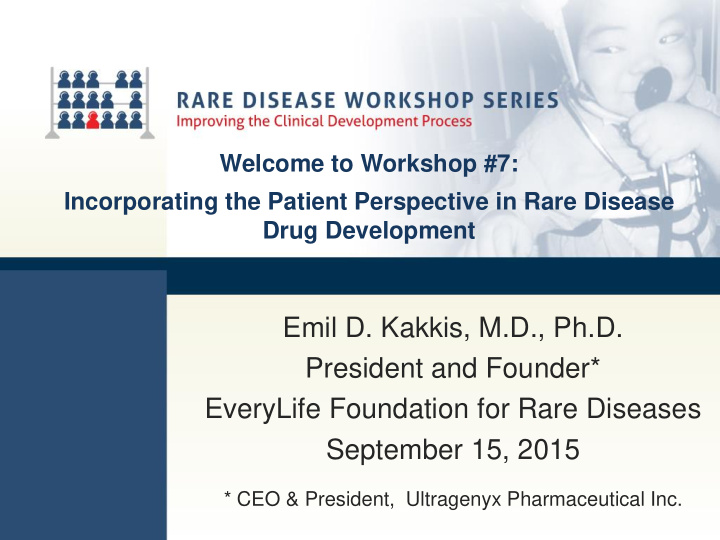



Welcome to Workshop #7: Incorporating the Patient Perspective in Rare Disease Drug Development Emil D. Kakkis, M.D., Ph.D. President and Founder* EveryLife Foundation for Rare Diseases September 15, 2015 * CEO & President, Ultragenyx Pharmaceutical Inc.
ANNUAL RARE DISEASE SCIENTIFIC WORKSHOP Improving the Clinical Development Process Thank You Scientific Workshop Sponsors
EveryLife Foundation For Rare Diseases Five years of Advocating for Rare Disease Drug Development • Focus on improving the development of treatments of rare diseases in February 2009 • Workshops, conferences and policy statements to help promote scientifically sound change • Supporter of ULTRA/FAST legislation in FDASIA, the OPEN ACT & 21 st Century Cures legislation 200 Partners+
Basic Principles for the EveryLife Foundation • No disease is too rare to deserve treatment • We could be doing more with the science we have • All drugs should be safe and effective
Workshop Series Topics • Workshop #1 Statistical analyses of rare disease studies • Workshop #2 Clinical evaluation of rare disease treatments • Workshop #3 Surrogate endpoints & accelerated approval • Workshop #4 Developing Policy Recommendations for Accelerated Approval • Workshop #5 Accelerated Approval in Rare Disease: Review of a White Paper Proposal • Workshop #6 Rationalizing Safety Testing to Enable Clinical Studies & Approval in the US for Rare Disease Treatments • Workshop #7 Incorporating the Patient Perspective in Rare Disease Drug Development Find slides from prior workshops at www.everylifefoundation.org
Specific Challenges in Rare Disease Drug Development and the need for Enhanced Patient Engagement? • Disease impact knowledge is often limited • Diseases are complex and multi-system • Large differences between physician impression and patient experiences • Finding optimal treatments requires understanding patient needs
Rare Disease Patient Engagement: How to do it? • Advisory Committee Public Sessions? • Large conferences or town hall meetings? • Advocacy by patient groups? • Testifying on Capital Hill? • Chained to the fences at FDA? Critical need for an improved quantitative and objective assessment of patient disease burden and treatment needs for effective inclusion in drug development and drug review
Goals of the Workshop • Discuss how to create a practical, quantitative, and scientifically rigorous approach for patient input • Explore various methodologies, case studies, or existing frameworks • Work toward a clear and scientifically sound framework for patient engagement
Agenda for Workshop #7 • Session A: Policies and Practices • Session B: Best Practices – Patient Organizations Leading the Way & Examples from Small & Large Drug Sponsors • Session C: Sample Frameworks & Implementation
One example: EveryLife Framework: Patients as Critical Partners in Rare Disease Drug Development Establishing Disease Burden, Disease Measurement, and Benefit-Risk Assessments as Part of Rare Disease Drug Development
Why and When to Engage Patients • Disease Burden – IND Stage – How does the disease impact patients? • Disease Measurement – Phase 1-2 – What are the relevant endpoints and tools for the assessment of important disease impacts? • Disease Treatment & Benefit-Risk – Phase 2-3 – How does the drug benefit and safety, compare with risks to patients relative to no treatment and also to their goals for treatment?
EveryLife Framework for Rare Disease Patient Engagement
More Comprehensive Picture of Disease Burden • Medical literature on rare diseases is often lacking, incomplete, and has misinformation • Disease burden survey using patient interviews and if needed physical measurement • Extensive cross-sectional survey with retrospective data may be a more practical alternative to long natural history studies
Establishing Disease Endpoints • Patient engagement is critical for developing a more comprehensive suite of endpoints • Endpoints can be selected and then tested in early stage “learn” studies • Types of Endpoints: – Clinical Non-Drug Survey Studies: testing methods without drug treatment involved • Test variety of tools and test methods with patients – PROs developed using interviews/item creation and then testing
Assessing Benefit-Risk: Evaluating Therapy Impact on Patients • Can be done theoretically at any time – Valuable example in PPMD program for DMD • By post-Phase 2, sufficient data is available to appreciate disease burden, efficacy and risks – Real data enhances the relevance of the assessment and utility to both Sponsor and regulators • Evaluate results with patients and assessment of efficacy relative to therapeutic goals and safety relative to risk tolerance of patients – Stem cell transplant example
Reconciling Risk Tolerance • Perception of risk and risk tolerance will vary among patients, clinicians, regulators, and drug developers • Patients with rare or life-threatening diseases may demonstrate high risk- tolerance given lack of alternatives • Important to incorporate patient risk tolerance, but patient risk tolerance should not be the sole basis for approval
EveryLife Framework for Rare Disease Patient Engagement
Formal Incorporation of Patient Input into the Drug Development Process • Consideration of inclusion of patient input sections in the Common Technical Document 2.5.1 Product Development Rationale • Clinical Overview 2.5 2.5.2 Overview of Biopharmaceutics 2.5.3 Overview of Clinical Pharmacology 2.5.4 Overview of Efficacy – New 2.5.6 on patient input 2.5.5 Overview of Safety 2.5.6 Overview of Patient Input 2.5.6 Benefits and Risks Conclusions 2.5.7 Literature References • Clinical Summary 2.7 2.7.1 Biopharmaceutic/ Analytical Methods 2.7.2 Clinical Pharmacology Studies 2.7 . 3 Clinical Efficacy – Section 2.7.5 on patient 2.7.4 Clinical Safety 2.7.5 Patient Input in Development input study summaries 2.7.5 Literature References 2.7.6 Synopses of Individual Studies • Submit patient input study reports – Like clinical study reports
Concluding Thoughts • Patients are ready and waiting to increase engagement • Sponsors and regulators need a scientifically rigorous framework for patient engagement • Must partner with patients, sponsors and regulators to get the best input for optimal rare disease drug development and regulation
Thank you! Questions? ekakkis@everylifefoundation.org mbronstein@everylifefoundation.org
ANNUAL RARE DISEASE SCIENTIFIC WORKSHOP Improving the Clinical Development Process Thank You Scientific Workshop Sponsors
Recommend
More recommend